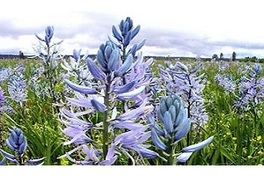
Camas Citizen Science Monitoring Program
To track camas lily flower populations
In a specific area
- Ongoing
More Information
The Camas Citizen Science Monitoring Program seeks to engage high school volunteers in the long-term scientific monitoring of camas lily populations in the Weippe Prairie site of Nez Perce National Historical Park. Students are trained in the classroom and then spend time in the field using data collection techniques specifically designed for this program. Results of the monitoring effort are available to National Park Service managers so that they can make better management decisions based on sound, scientific information.
Camas is an important cultural and natural resource. For the last 7,000 years, camas has been an important part of the Nez Perce history, life and culture, as well as those of many other tribes of the Pacific Northwest. In addition, camas is one of a suite of wetland species associated with seasonal wet prairie ecosystems. However, as a result of recent agricultural conversion, irrigation, flood control, and other land use practices, remaining wet prairies in this region have been drastically reduced. Projected climate change will also impact these wet prairie ecosystems and monitoring camas populations will provide the National Park Service an opportunity to track climate change impacts on park natural resources.
Monitoring of camas and invasive weeds is a unique opportunity to integrate natural resource monitoring with the cultural history of the Nez Perce people. Citizen scientists will use carefully designed scientific procedures and modern technology to collect data, such as the number of camas plants and flowering plants and the presence of invasive species. Components of the program are tied to state science standards, and high school students will work alongside ecologists, statisticians, natural resource managers, and interpretive rangers.
Three local high schools are currently participating each year. This is a unique learning opportunity that students are sure to remember.
Ticket Required: No
Minimum Age: 13
Languages: English
